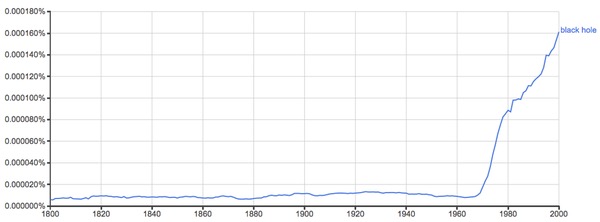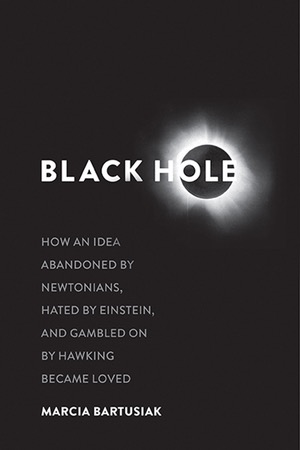Review: Black Holeby Jeff Foust
|
 A Google Books “n-gram” chart showing the rise in the use of the phrase “black hole” in books since the late 1960s. (credit: Google) |
The origins of the phrase “black hole” is just one of the many interesting sections of the book of the same name by science writer Marcia Bartusiak. In less than 200 pages (excluding endnotes), she offers a concise but comprehensive history of this class of astronomical objects, from the 18th century ponderings of stars massive enough that light could not escape to present-day studies of these very real objects.
The book, while nominally about the history of black hole studies, is in many respects a history of general relativity. This year marks the centennial of Albert Einstein’s publication of his theory, which described the warping of spacetime by gravity. A famous observation of stars during a 1919 solar eclipse, showing their positions shifted as their light was warped by the Sun, provided a confirmation of general relativity and catapulted Einstein to fame.
General relativity itself, though, faded into obscurity. In the 1920s and ’30s, physicists focused their attention on the emerging field of quantum mechanics as well as particle physics, where there was a strong link between theory and experimentation. General relativity was a backwater with little obvious relevance to other parts of physics, so much so that, by the 1950s, the editor of the leading journal Physical Review considered rejecting any new papers on general relativity.
| By the 1950s, the editor of the leading journal Physical Review considered rejecting any new papers on general relativity. |
Wheeler and a handful of other physicists resuscitated general relativity in the 1950s and ’60s, combining theory with observations. Described by Bartusiak and “America’s dean of general relativity,” Wheeler and his students at Princeton University turned their attention to the role general relativity played in the collapse of massive stars. Others soon followed suit, and by the mid-1960s physicists had developed models of rotating collapsed stars that incorporated general relativity, just as astronomers started discovering mysterious, powerful objects dubbed quasars, now thought to be powered by black holes. General relativity escaped irrelevance thanks to an object from which there is no escape.
Bartusiak expertly tells the story of the emergence of black holes, and the redemption of general relativity, offering just enough about the science to provide a layperson with a grasp without bogging the reader down with equations or weightier details. She mixes that with profiles of the people involves in these studies, and what motivated them to pursue research that, for many years, was well off the beaten path in physics.
Since the use of general relativity a half-century ago to explain black holes, the theory has found new relevance, and even practical applications: navigation satellites, like the American Global Positioning System (GPS), have to take general relativity into account in order to maintain their accuracy. Black holes have yet to find a similar practical application—unless you count the adoption of the term itself in modern culture.
